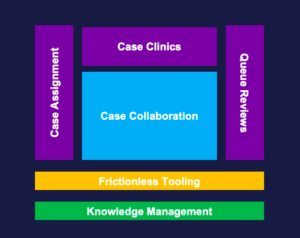The Right Environment for Swarming Success
 Last month, I talked about the organizational culture required for swarming to flourish. This time, I’m tackling the larger ecosystem of the processes required for swarming. It’s not enough to set up a process to collaborate for case resolution: success requires a comprehensive set of auxiliary processes.
Last month, I talked about the organizational culture required for swarming to flourish. This time, I’m tackling the larger ecosystem of the processes required for swarming. It’s not enough to set up a process to collaborate for case resolution: success requires a comprehensive set of auxiliary processes.
Accurate Case Assignments
While it’s wonderful to count on a larger group to help resolve issues, it’s even better if you can assign the right individual from the get-go (in other words: no collaboration is best!). This means:
- gathering as much information from customers upfront–not just “I need help”.
- allowing the support engineers to select the issues they work on (and controlling the effects of potential cherry-picking) or using an AI-driven process to get a good match.
Proactive Case Clinics
Yes, support engineers can ask for help with individual cases, but it’s very useful to be able to discuss tough cases in a public forum and in real time. Regular, typically daily case clinics help, during which anyone can bring up tough cases and ask for help. They are driven by senior engineers who provide help right on the spot, refer to existing resources, and also bring up issues they came across.
Regular Queue Reviews
One of the main challenge with tierless support is backlog management, as cases can pile up when support engineers don’t know what to do next. By reviewing individual queues, managers can encourage case owners to attend case clinics or request help on specific cases.
Frictionless Tooling
Processes are always more important than tools, but when it comes to collaboration a good tool makes a difference. It should be easy to request help, to direct the request to the proper group, and, from the other side, to become aware of collaboration requests and manage them alongside cases.
Knowledge Management
Knowledge management is a prerequisite for collaboration. If there is no knowledge base, build it by requesting that each collaboration request result either in reusing existing materials or creating a new document.
If one or more of these auxiliary processes is missing, you can still move towards collaborative support–but build as you go!
And tell us about how you are organizing your environment to make collaboration work.









